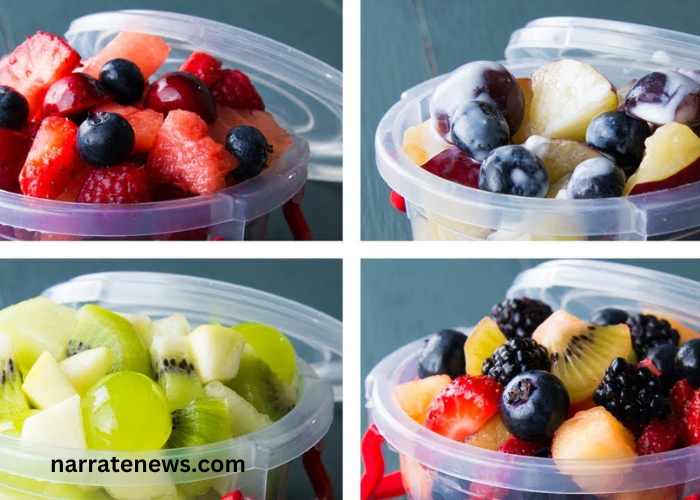
The Fruit Salad Diet for Weight Loss and Wellness
In the quest for effective and sustainable weight loss, the fruit salad diet emerges as a refreshing and nutritious approach. Bursting with vitamins, minerals, and antioxidants, fruits not only tantalize the taste buds but also provide a plethora of health benefits. This article will delve into the intricacies of the fruit salad diet, exploring its potential for weight loss, offering practical tips, and addressing considerations for a balanced and enjoyable journey toward a healthier lifestyle.
Fruit Salad Diet for Weight Loss
The Nutritional Bounty of Fruit
Before delving into the specifics of the fruit salad diet for weight loss, it’s crucial to understand the nutritional powerhouse that fruits represent. Fruits are rich in essential vitamins, including vitamin C, potassium, and various B vitamins. They also contain dietary fiber, antioxidants, and natural sugars that contribute to overall well-being.
Fiber:
Fruits are an excellent source of dietary fiber, which aids digestion, promotes satiety, and helps regulate blood sugar levels. Fiber also contributes to a feeling of fullness, reducing the likelihood of overeating.
Antioxidants:
The vibrant colors of fruits are indicative of their antioxidant content. Antioxidants combat oxidative stress in the body, reducing inflammation and protecting cells from damage. This can have implications for both weight loss and overall health.
Hydration:
Many fruits have high water content, contributing to hydration. Proper hydration is essential for various bodily functions and can also be beneficial for weight management by promoting a feeling of fullness.
Low in Calories:
Most fruits are naturally low in calories, making them a smart choice for those seeking to reduce calorie intake for weight loss.
The Fruit Salad Diet: A Delectable Path to Weight Loss
The fruit salad diet is not a one-size-fits-all approach; rather, it is a customizable and flexible way to incorporate a variety of fruits into your daily meals. Here’s a breakdown of how the fruit salad diet can be structured for effective weight loss:
Variety is Key:
The beauty of the fruit salad diet lies in its diversity. By combining a colorful array of fruits, you not only enhance the visual appeal of your meals but also ensure a broad spectrum of nutrients. Opt for a mix of berries, citrus fruits, melons, and tropical fruits to create a palate-pleasing medley.
Portion Control:
While fruits are nutrient-dense and generally low in calories, moderation is still key. Be mindful of portion sizes to avoid excessive calorie intake. A well-portioned fruit salad can serve as a satisfying and guilt-free snack or meal.
Include Protein and Healthy Fats:
To make your fruit salad more balanced and satiating, consider adding sources of protein and healthy fats. Greek yogurt, cottage cheese, nuts, and seeds are excellent choices. Protein and fats contribute to a feeling of fullness, preventing rapid spikes and crashes in blood sugar levels.
Mindful Eating:
Take the time to savor each bite of your fruit salad. Mindful eating promotes awareness of hunger and fullness cues, reducing the likelihood of overeating. Sit down, enjoy the flavors, and appreciate the nourishment your body is receiving.
Hydration with Infusions:
Elevate your fruit salad experience by incorporating hydrating elements. Consider adding mint leaves, a splash of citrus juice, or even infusing your salad with naturally flavored water. Staying well-hydrated is crucial for overall health and can contribute to a sense of fullness.
Weight Loss Mechanisms of the Fruit Salad Diet
Understanding how the fruit salad diet aids in weight loss involves recognizing several key mechanisms:
Calorie Control:
Fruits are generally low in calories compared to many processed snacks and desserts. By incorporating fruit salads into your diet, you can enjoy a satisfying volume of food with fewer calories, making it easier to maintain a caloric deficit for weight loss.
Fiber’s Role in Satiety:
The fiber content in fruits contributes to feelings of fullness and satiety. This can help control appetite and reduce the likelihood of overeating during meals and snacks.
Natural Sugars vs. Added Sugars:
While fruits contain natural sugars, they also come with fiber, which slows down the absorption of sugar in the bloodstream. This is in stark contrast to added sugars found in many processed foods, which can contribute to weight gain and metabolic issues.
Hydration and Weight Management:
The high water content in fruits contributes to hydration, and staying well-hydrated is associated with better weight management. Sometimes, our bodies can mistake thirst for hunger, leading to unnecessary calorie consumption.
Nutrient Density:
Fruits are not just a source of empty calories; they are packed with essential vitamins, minerals, and antioxidants. Choosing nutrient-dense foods ensures that your body receives the necessary components for overall health, even as you work towards weight loss.
Creating a Balanced Fruit Salad Diet Plan
While the fruit salad diet holds promise for weight loss, balance and variety are essential. Consider the following tips to create a well-rounded and sustainable fruit salad diet plan:
Include a Rainbow of Colors:
Different colors in fruits indicate distinct nutrient profiles. Aim to include a variety of colors in your fruit salad to ensure a broad range of vitamins, minerals, and antioxidants.
Pair with Lean Proteins:
Enhance the satiety factor of your fruit salad by pairing it with lean protein sources. Greek yogurt, grilled chicken, or tofu are excellent choices that add protein without overwhelming the refreshing quality of the fruit.
Incorporate Healthy Fats:
Add a dose of healthy fats to your fruit salad by including nuts, seeds, or a drizzle of olive oil. These additions contribute to a well-rounded nutritional profile and help keep you feeling satisfied.
Mindful Snacking:
Use fruit salads as a go-to snack option. Whether at home, work, or on the go, having a pre-prepared fruit salad makes it convenient to choose a nutritious and satisfying snack over less wholesome options.
Experiment with Herbs and Spices:
Elevate the flavor profile of your fruit salad by experimenting with herbs and spices. Mint, basil, cinnamon, and a touch of honey can add a burst of flavor without compromising healthfulness.
Stay Hydrated:
Hydration is key to overall health and well-being. Complement your fruit salad with plenty of water to support digestion and maintain optimal hydration levels.
Consider Individual Nutritional Needs:
The fruit salad diet should be adapted to individual nutritional needs and dietary requirements. Consult with a healthcare professional or a registered dietitian to ensure your diet aligns with your specific health goals.
Potential Challenges and Considerations
While the fruit salad diet offers numerous benefits, it’s important to be aware of potential challenges and considerations:
Sugar Content:
While the natural sugars in fruits come with fiber and essential nutrients, individuals with conditions like diabetes may need to monitor their fruit intake. It’s advisable to consult with a healthcare professional or a registered dietitian for personalized advice.
Dental Health:
The acidity in some fruits can affect dental health. To mitigate this, consider rinsing your mouth with water after consuming fruit or opting for fruits with lower acidity levels.
Balancing Macronutrients:
While fruits provide essential vitamins and minerals, they may lack some macronutrients, such as fat and protein. Ensuring a balance of macronutrients is crucial for overall health and sustained weight loss.
Individual Preferences:
The fruit salad diet may not suit everyone’s taste preferences or dietary needs. It’s essential to find an approach to weight loss that aligns with individual lifestyles and culinary choices.
Sample Fruit Salad Diet Plan
To offer practical insights into incorporating the fruit salad diet into daily life, here’s a sample meal plan:
Breakfast: Berry Blast Yogurt Parfait
Greek yogurt
Mixed berries (strawberries, blueberries, raspberries)
Granola
Drizzle of honey
Lunch: Tropical Paradise Salad
Pineapple chunks
Mango slices
Kiwi slices
Shredded coconut
Chopped mint leaves
Snack: Citrus Fiesta
Orange segments
Grapefruit wedges
Sprinkle of chili powder for a kick
Dinner: Grilled Chicken and Mixed Greens Salad
Mixed greens (spinach, arugula, kale)
Grilled chicken breast strips
Sliced strawberries
Walnut halves
Balsamic vinaigrette dressing
Dessert: Summer Melon Medley
Watermelon cubes
Cantaloupe balls
Mint leaves for garnish
Conclusion: Nourishing the Body, Savoring Success
The fruit salad diet embodies a holistic approach to weight loss, emphasizing the importance of nutrient-dense, whole foods. By incorporating a variety of fruits into your daily meals, you not only embark on a journey toward weight loss but also prioritize overall wellness.
As with any dietary plan, individual preferences, nutritional needs, and health considerations should guide your choices. Whether you’re seeking a refreshing snack, a satisfying meal, or a burst of natural energy, the fruit salad diet invites you to savor the abundance of flavors and nutrients nature has to offer.
In your pursuit of a healthier lifestyle, embrace the colorful world of fruits, relish the journey of creating delightful fruit salads, and celebrate the nourishment that contributes to your well-being. The fruit salad diet is not just a means to an end; it’s a flavorful and sustainable path toward a healthier, more vibrant you.


